Single-Phase Heat Transfer Characteristics of Water in an Industrial Plate and Shell Heat Exchanger under High-Temperature Conditions
Abstract
:1. Introduction
2. Experimental Apparatus and Test Procedure
2.1. Experimental Apparatus
2.2. Data Reduction
3. Results and Discussion
3.1. Convective Heat Transfer Coefficient
3.2. Pressure Drop
3.3. Temperature Profile on the Circular Plate
4. Conclusions
Author Contributions
Funding
Institutional Review Board Statement
Informed Consent Statement
Data Availability Statement
Acknowledgments
Conflicts of Interest
Nomenclature
| A | heat transfer area (m2) |
| b | corrugation depth (m) |
| Cp | specific heat (kJ kg−1 K−1) |
| D | diameter (m) |
| Dh | hydraulic diameter (m) |
| f | friction factor (-) |
| G | mass flux (kg m−2 s−1) |
| h | heat transfer coefficient (kW m−2 K−1) |
| k | thermal conductivity (kW m−1 K−1) |
| L | length (m) |
| LMTD | log mean temperature difference (K) |
| mass flow rate (kg s−1) | |
| N | number of plates (-) |
| Nu | Nusselt number (-) |
| P | pressure (kPa) |
| Pr | Prandtl number (-) |
| heat transfer rate (W or kW) | |
| q″ | heat flux (kW m−2) |
| Re | Reynolds number (-) |
| T | temperature (°C or K) |
| t | plate thickness (m) |
| U | overall heat transfer coefficient (kW m−2 K−1) |
| volume flow rate (m3 h−1) | |
| Greek symbols | |
| α | dimensionless corrugation parameter |
| β | chevron angle (°) |
| Δ | difference (-) |
| λ | corrugation pitch (m) |
| μ | viscosity (kg m−1 s−1) |
| υ | specific volume (m3 kg−1) |
| ρ | density (kg m−3) |
| ϕ | surface enlargement factor (-) |
| Subscripts | |
| avg | average |
| c | cold side |
| ch | channel |
| eff | effective |
| f | liquid phase |
| h | hot side |
| in | inlet |
| out | outlet |
| plate | plate |
| port | port |
| shell | shell |
| w | water |
| wall | wall |
| Acronyms | |
| BPHE | brazed plate heat exchanger |
| PHE | plate heat exchanger |
| PSHE | plate and shell heat exchanger |
| STHE | shell and tube heat exchanger |
References
- IEA. Energy Technology Perspective; IEA: Paris, France, 2017. [Google Scholar]
- Vahterus Company. Available online: http://vahterus.com (accessed on 23 September 2021).
- Hesselgreaves, J.E. Compact Heat Exchangers Selection, Design and Operation, 1st ed.; Pergamon: Edinburgh, UK, 2001; pp. 60–61. [Google Scholar]
- Lim, J.; Song, K.S.; Kim, D.; Lee, D.C.; Kim, Y. Condensation heat transfer characteristics of R245fa in a shell and plate heat exchanger for high-temperature heat pumps. Int. J. Heat Mass Transfer 2018, 127, 730–739. [Google Scholar] [CrossRef]
- Song, K.S.; Yun, S.; Lee, D.C.; Kim, K.; Kim, Y. Evaporation heat transfer characteristics of R-245fa in a shell and plate exchanger for very-high-temperature heat pumps. Int. J. Heat Mass Transfer 2020, 151, 119408. [Google Scholar] [CrossRef]
- Jo, C.U.; Lee, D.C.; Chung, H.J.; Kang, Y.; Kim, Y. Comparative evaluation of the evaporation heat transfer characteristics of a low-GWP refrigerant R-1234ze(E) between shell and plate and plate heat exchangers. Int. J. Heat Mass Transfer 2020, 153, 119598. [Google Scholar] [CrossRef]
- Park, J.H.; Kim, Y.S.; Seo, M.G. Experimental study on R-134a condensation heat transfer characteristics in plate and shell heat exchangers. In Proceedings of the International Refrigeration Air Conditioning Conference, Purdue, IN, USA, 24–28 May 2002; p. 562. [Google Scholar]
- Kwon, O.J.; Jung, J.H.; Kang, Y.T. Development of experimental Nusselt number and friction factor correlation of R-1233zd(E) in plate heat exchangers. Int. J. Heat Mass Transfer 2020, 158, 120008. [Google Scholar] [CrossRef]
- Abbas, A.; Lee, H.; Sengupta, A.; Wang, C.C. Numerical investigation of thermal and hydraulic performance of shell and plate heat exchanger. Appl. Therm. Eng. 2020, 167, 114705. [Google Scholar] [CrossRef]
- Gherasim, I.; Taws, M.; Galanis, N.; Nguyen, C.T. Heat transfer and fluid in a plate heat exchanger part I. Experimental investigation. Int. J. Therm. Sci. 2011, 50, 1492–1498. [Google Scholar] [CrossRef]
- Martin, H. A theoretical approach to predict the performance of chevron-type plate heat exchangers. Chem. Eng. Proc. 1996, 35, 301–310. [Google Scholar] [CrossRef]
- Shah, R.K.; Focke, W.W. Plate Heat Exchangers and Their Design Theory, Heat Transfer Equipment Design; Hemisphere Publishing: Washington, DC, USA, 1988. [Google Scholar]
- Moffat, R.J. Describing the uncertainties in experimental results. Exp. Therm. Fluid Sci. 1998, 1, 3–17. [Google Scholar] [CrossRef] [Green Version]
- ASHRAE. ASHRAE Guideline 2–2010 (RA2014). Engineering Analysis of Experimental Data; ASHRAE: Atlanta, GA, USA, 2014. [Google Scholar]
- Fernandez-Seara, J.; Uhia, F.J.; Sieres, J.; Campo, A. A general review of the Wilson plot method and its modifications to determine convection coefficients in heat exchanger devices. Appl. Therm. Eng. 2007, 27, 2745–2757. [Google Scholar] [CrossRef] [Green Version]
- Lee, H.; Li, S.; Hwang, Y.; Radermacher, R.; Chun, H.H. Experimental investigations on flow boiling heat transfer in plate heat exchanger at low mass flux condition. Appl. Therm. Eng. 2013, 61, 408–415. [Google Scholar] [CrossRef]
- Heavner, R.L.; Kumar, H.; Wanniarachchi, A.S. Performance of an industrial plate heat exchangers: Effect of chevron angle. In AIChE Symposium Series; American Institute of Chemical Engineers: New York, NY, USA, 1993; Volume 89, pp. 262–267. [Google Scholar]
- Nilpueng, K.; Wongwises, S. Experimental study of single-phase heat transfer and pressure drop inside a plate heat exchanger with a rough surface. Exp. Therm. Fluid Sci. 2015, 68, 268–275. [Google Scholar] [CrossRef]
- Hayes, N.; Jokar, A.; Ayub, Z.H. Study of carbon dioxide condensation in chevron plates exchangers, heat transfer analysis. Int. J. Heat Mass Transfer. 2011, 54, 1121–1131. [Google Scholar] [CrossRef]
- Talik, A.C.; Fletcher, L.S.; Anand, N.K.; Swanson, L.W. Heat transfer and pressure drop characteristics of a plate heat exchanger. In Proceedings of the ASME/JSME Thermal Engineering Conference, New York, NY, USA, 31 December 1995; pp. 321–329. [Google Scholar]
- Gulenoglu, C.; Akturk, F.; Aradag, S.; Uzol, N.S.; Kakac, S. Experimental comparison of performances of three different plates for gasketed plate heat exchangers. Int. J. Therm. Sci. 2014, 75, 249–256. [Google Scholar] [CrossRef]

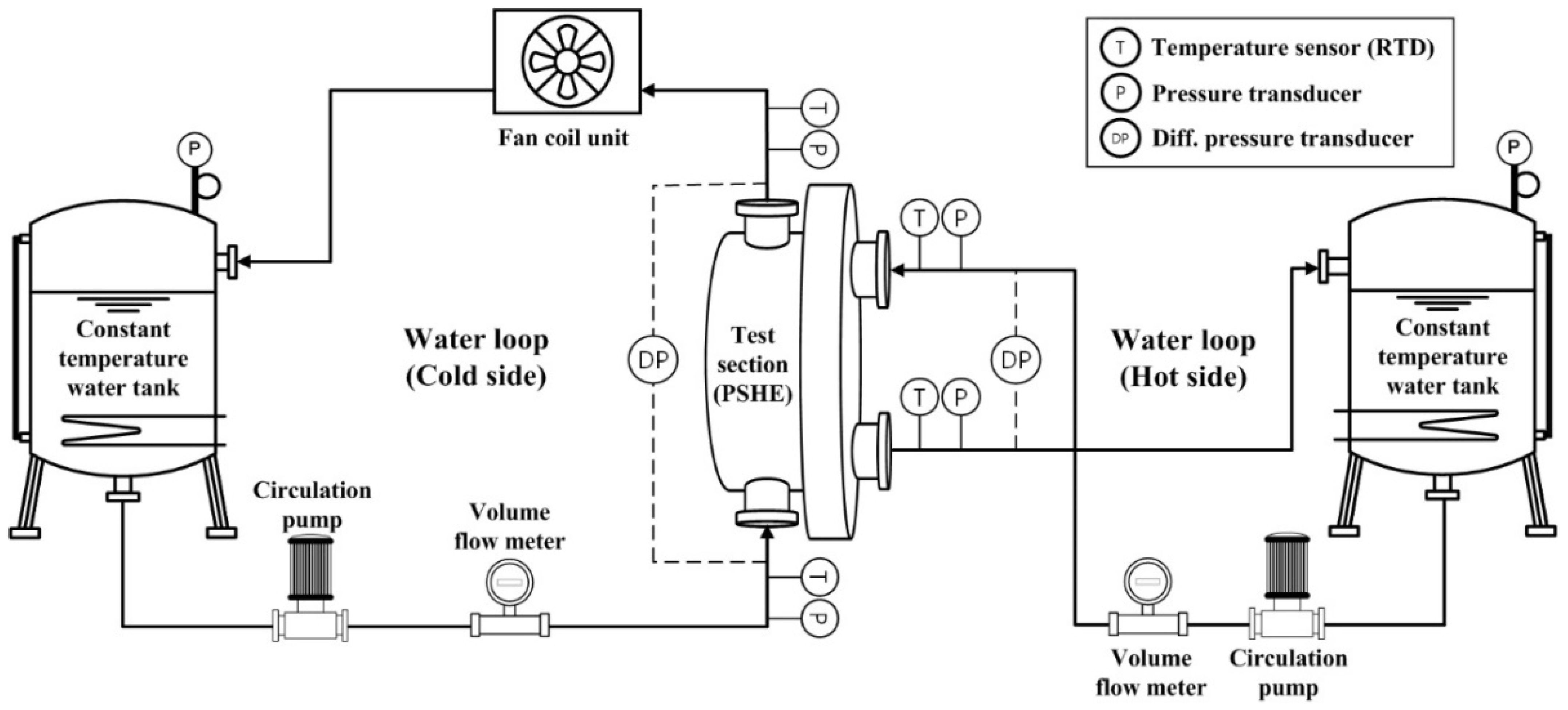
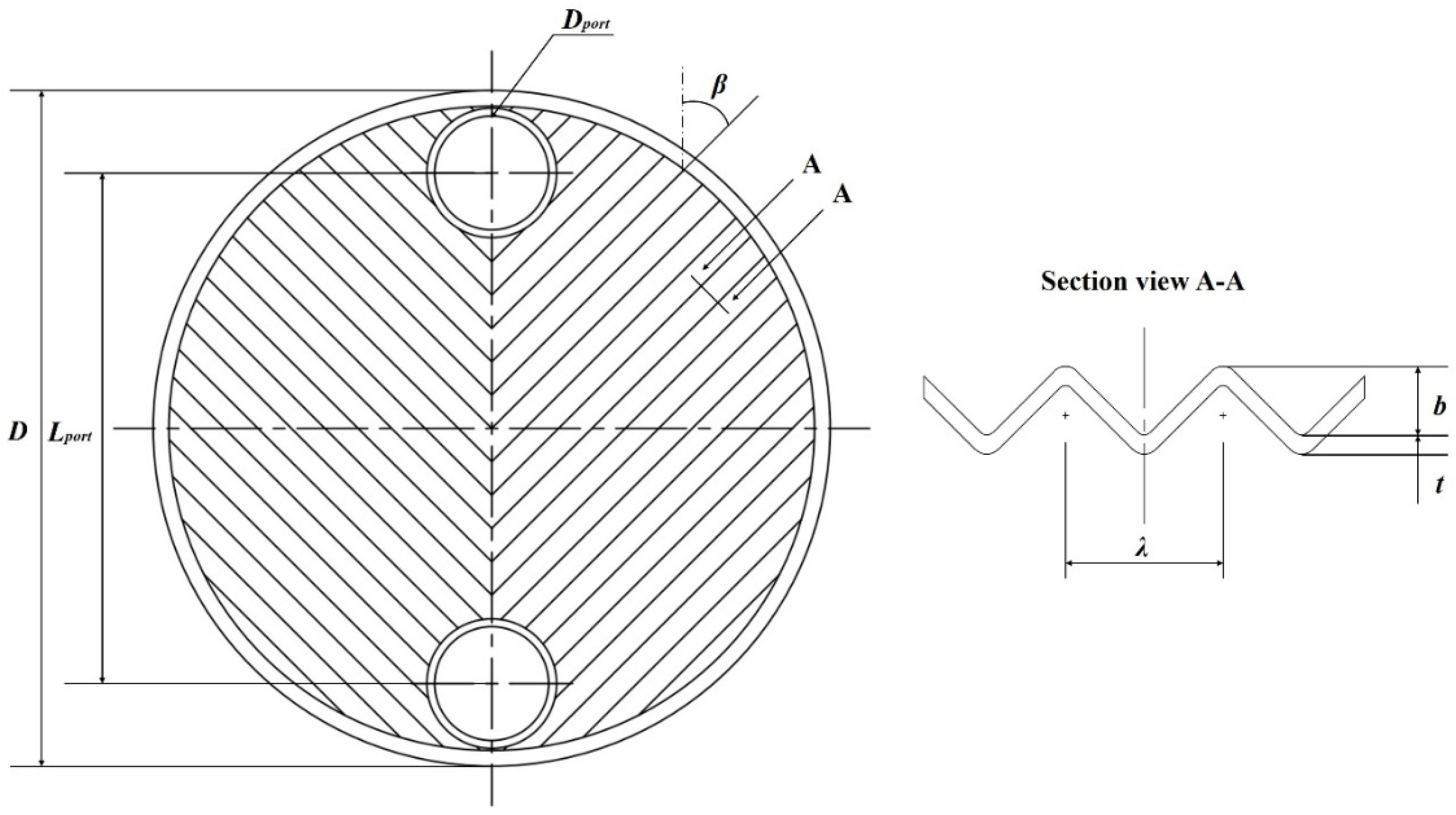
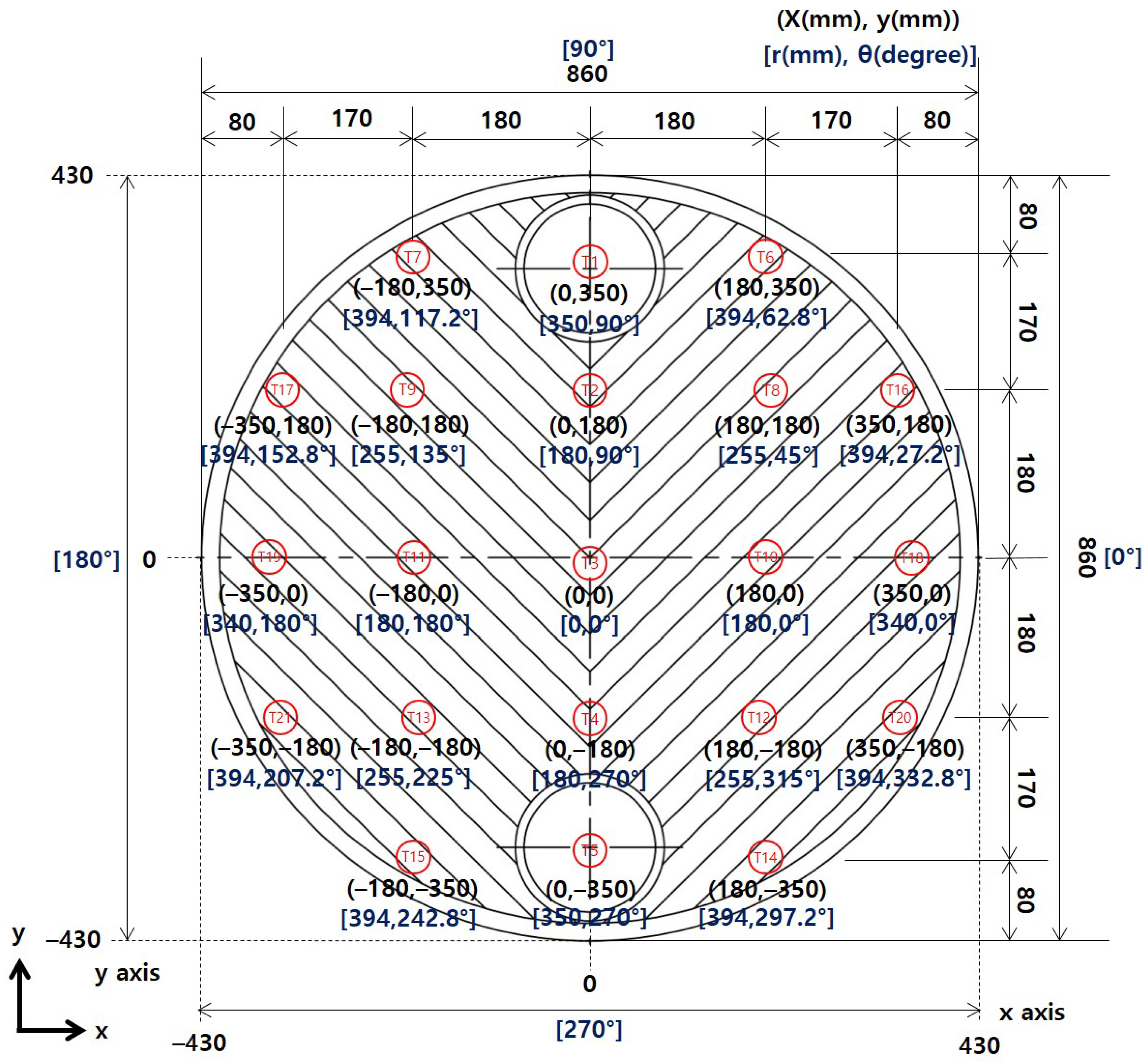



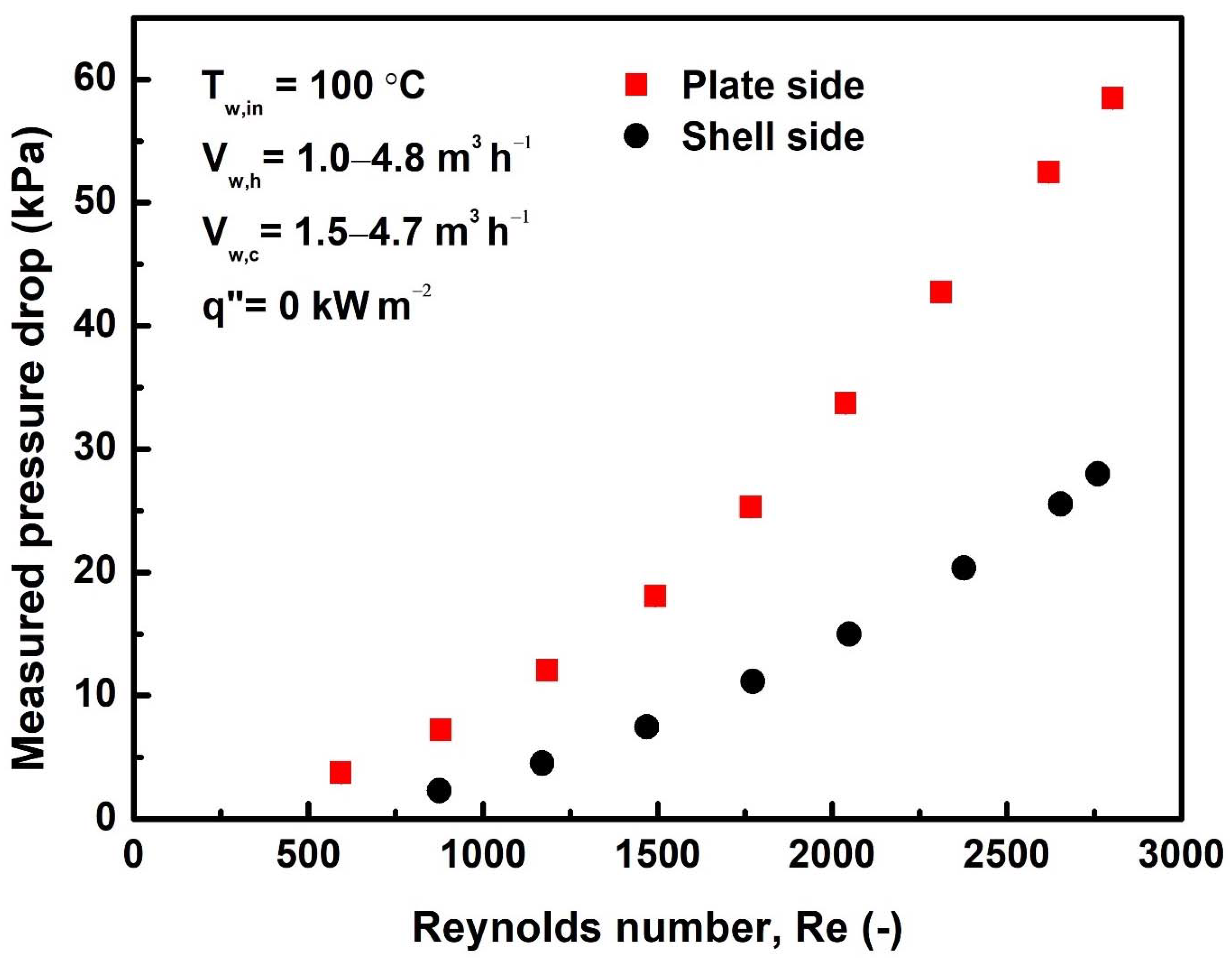
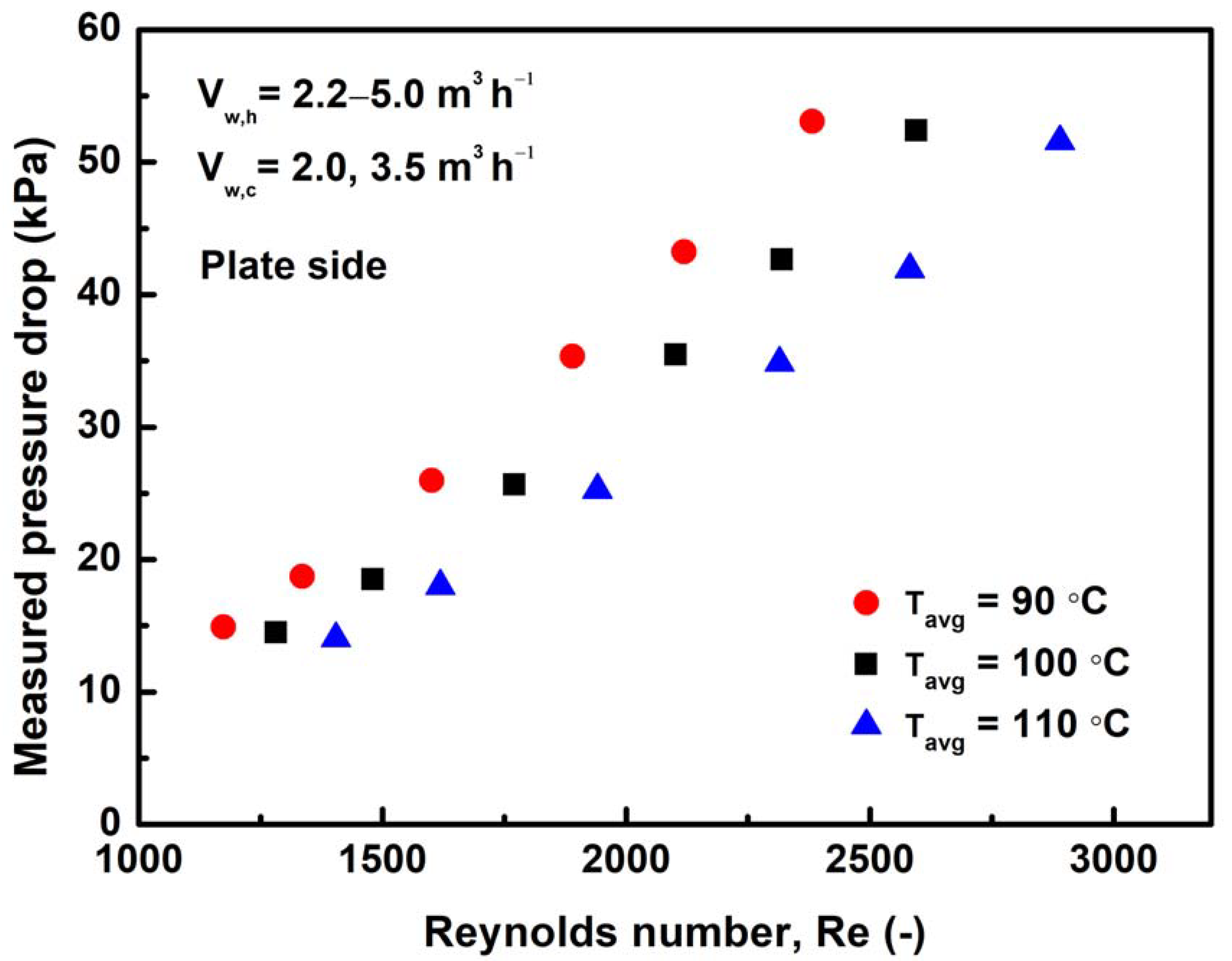


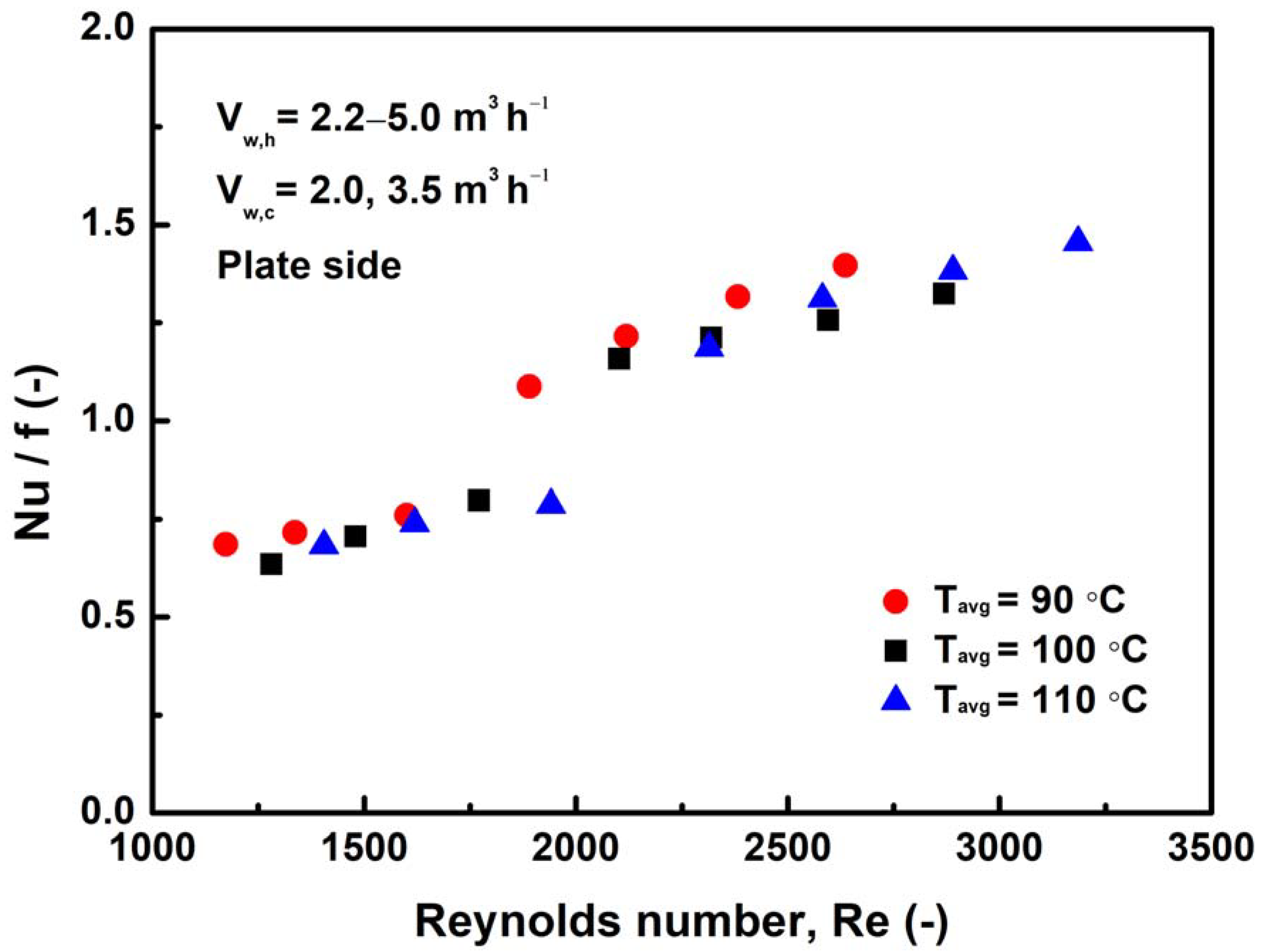
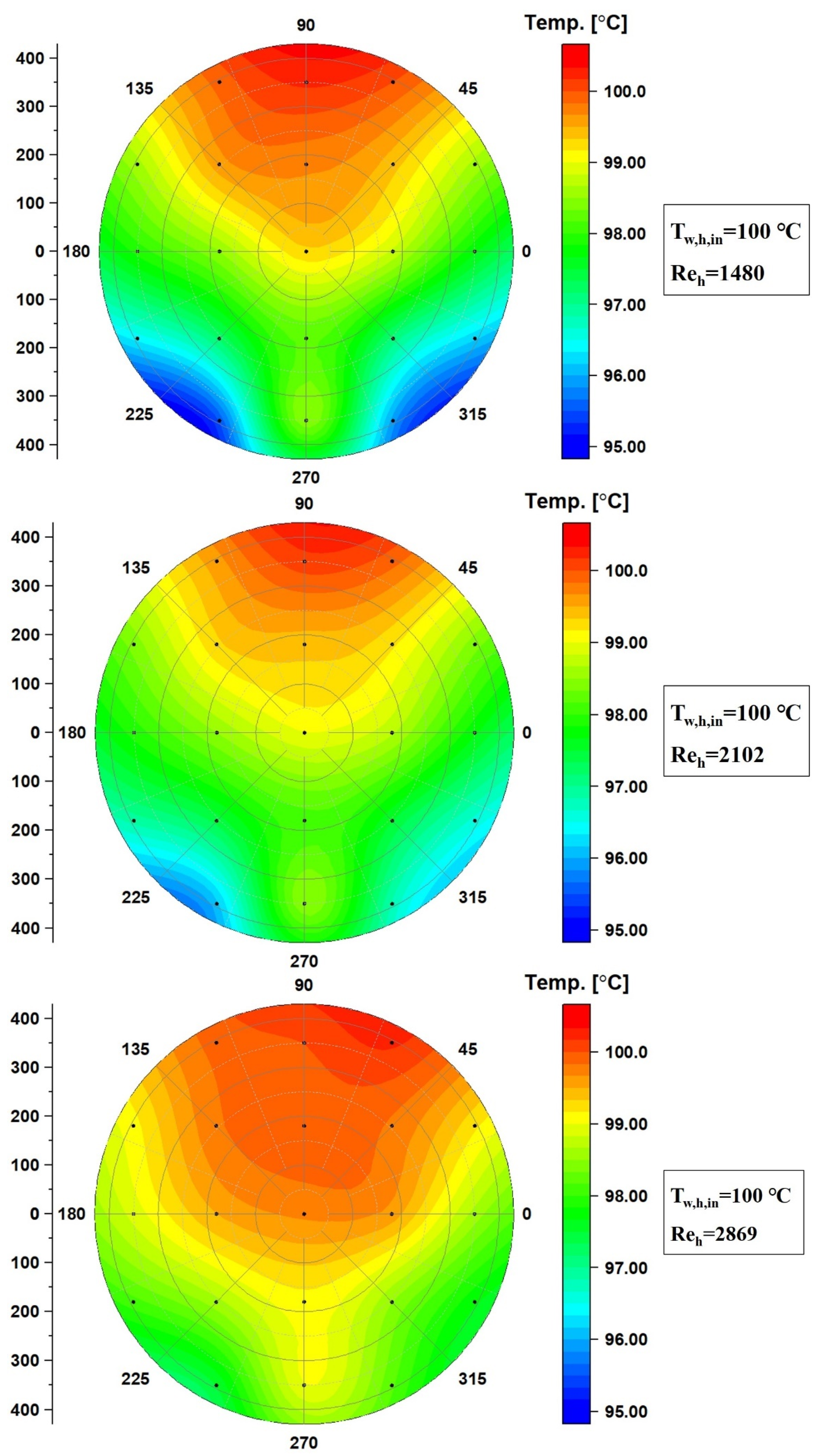
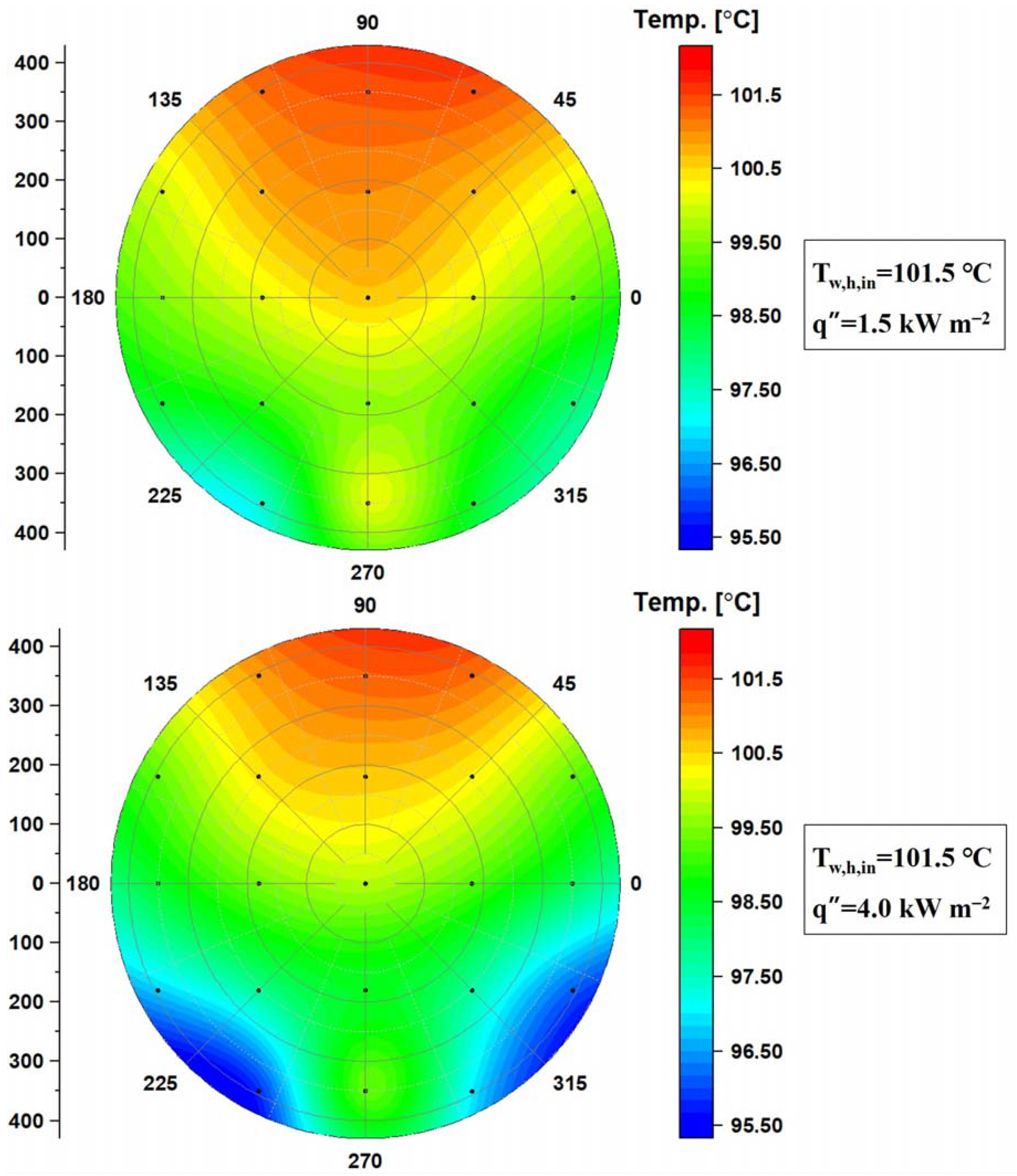

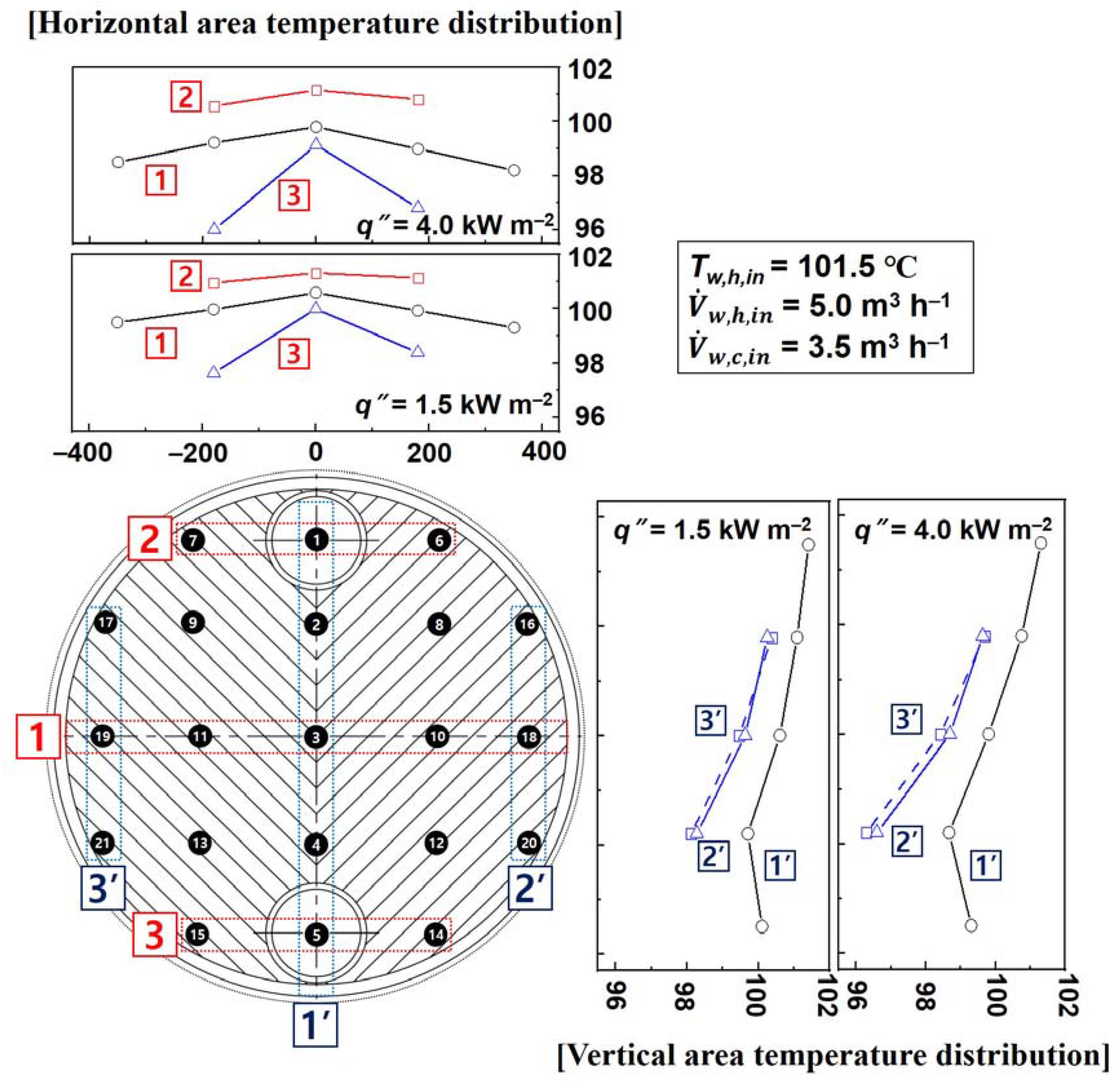
| Geometries | Symbol | Value |
|---|---|---|
| Plate diameter (m) | D | 0.86 |
| Port diameter (m) | Dport | 0.145 |
| Port to port length (m) | Lport | 0.65 |
| Chevron angle (°) | β | 45 |
| Plate thickness (m) | t | 0.0008 |
| Corrugation pitch (m) | λ | 0.012 |
| Corrugation depth (m) | b | 0.003 |
| Hydraulic diameter (m) | Dh | 0.005 |
| Surface enlargement factor (-) | ϕ | 1.170 |
| Number of plates (-) | Nplate | 4 |
| Effective heat transfer area (m2) | Aeff | 2.619 |
| Operating Variables | Range |
|---|---|
| Average temperature, Tavg (°C) | 90, 100, 110 |
| (m3 h−1) | 1.0–5.0 |
| (m3 h−1) | 1.5–4.7 |
| Heat flux, q″ (kW m−2) | 1.5–4.0 (No heat flux for pressure drop tests) |
| Parameters | Specification and Uncertainty | |
|---|---|---|
| Temperature, T | Model | RTD Omega PM 1/3 DIN |
| Range | 0–250 °C | |
| Accuracy | ±1/3 (0.3 + 0.005lTl) | |
| Pressure, P | Model | Aplisen PCD-28D |
| Range | 0–10 bar, 0–40 bar | |
| Accuracy | ±0.2% of full scale | |
| Differential pressure, ΔP | Model | Yokogawa EJA110E |
| Range | 1–300 kPa | |
| Accuracy | ±0.055% of span | |
| Model | Rosemount 8732C | |
| Range | 0–6 m3 h−1 | |
| Accuracy | ±0.35% of span | |
| Log mean temperature difference, LMTD | Uncertainty | ±3.1% |
| Heat flux, q″ | ±7.1% | |
| Mass flux, G | ±1.0% | |
| Overall heat transfer coefficient, U | ±7.5% | |
| Heat transfer coefficient of hot side, hw,h | ±7.3% | |
| Heat transfer coefficient of cold side, hw,c | ±7.8% | |
| Fiction factor, f | ±6.1% | |
Publisher’s Note: MDPI stays neutral with regard to jurisdictional claims in published maps and institutional affiliations. |
© 2021 by the authors. Licensee MDPI, Basel, Switzerland. This article is an open access article distributed under the terms and conditions of the Creative Commons Attribution (CC BY) license (https://creativecommons.org/licenses/by/4.0/).
Share and Cite
Kim, K.; Song, K.S.; Lee, G.; Chang, K.; Kim, Y. Single-Phase Heat Transfer Characteristics of Water in an Industrial Plate and Shell Heat Exchanger under High-Temperature Conditions. Energies 2021, 14, 6688. https://doi.org/10.3390/en14206688
Kim K, Song KS, Lee G, Chang K, Kim Y. Single-Phase Heat Transfer Characteristics of Water in an Industrial Plate and Shell Heat Exchanger under High-Temperature Conditions. Energies. 2021; 14(20):6688. https://doi.org/10.3390/en14206688
Chicago/Turabian StyleKim, Kibong, Kang Sub Song, Gilbong Lee, Kichang Chang, and Yongchan Kim. 2021. "Single-Phase Heat Transfer Characteristics of Water in an Industrial Plate and Shell Heat Exchanger under High-Temperature Conditions" Energies 14, no. 20: 6688. https://doi.org/10.3390/en14206688
APA StyleKim, K., Song, K. S., Lee, G., Chang, K., & Kim, Y. (2021). Single-Phase Heat Transfer Characteristics of Water in an Industrial Plate and Shell Heat Exchanger under High-Temperature Conditions. Energies, 14(20), 6688. https://doi.org/10.3390/en14206688






